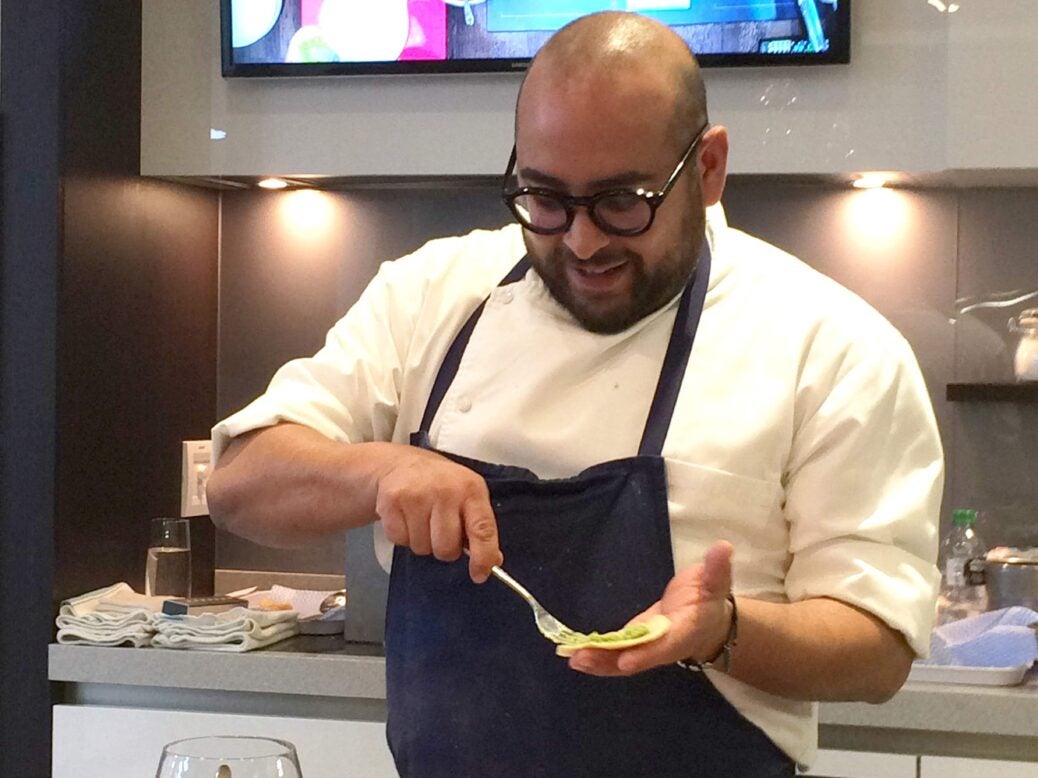
Mexico’s new cuisine has the wind in its sails. Michael Watts heads to Lancashire to sample the work of one of the world’s finest chefs.
According to the Victorians, ash from a spent fire is a wonderful, all-purpose remedy for managing household ills. Ashes produced by burning wood or hay can be used to brush one’s teeth, remove stains from furniture, floors and clothes, repel moths and vermin and, counterintuitively, put out a blaze, although perhaps only Bear Grylls would now think of cleaning his teeth with the stuff. They had much less to say about mixing ash with food, yet the practice has a venerable, scientific history, especially in cheese-making. Today it has become a fine-dining innovation, this year’s potato foam, which is somewhat comical, I grant you, but the search for novelty in modern cuisine is relentless.
At Noma in Copenhagen, frequently voted the best restaurant in the world, René Redzepi rubs root vegetables with hay ash to impart a pleasantly bitter, smoky tang, and then bakes them in a salt-crust pastry. In fact, he’s simply adapting a Nordic tradition. The Norwegian staple of lutefisk, for example, is cod that’s been preserved with lye, or wood ash, a technique long-established in the US. The Deep South breakfast of ‘hominy grits’, a porridge of Native American origin, is a product of maize soaked in diluted lye. And where would Latin America be without its tortillas and tamales, which are made from masa seca, a cornmeal of dried, ground maize?
These reflections are prompted by an exciting, young Mexican chef, for whom using ash is a step towards re-energising his native cuisine. Diego Hernández Baquedano, who owns a restaurant in north-west Mexico, was one of fourteen international chefs recently invited to cook at Obsession, the prestigious culinary festival held every year at Northcote country-house hotel in Lancashire’s Ribble Valley. Hapless cremation of a dish is the cardinal sin of cooking, but Hernández, as he prefers to be called, can create improbable magic from incinerated vegetables. It’s really quite simple. Leeks, onions, turnips, celeriac, spring onions are cooked for a long time at a low temperature until dried and blackened and then ground to a powder.
In February, he demonstrated his skills for selected Spear’s readers gathered at the chef’s table in Northcote’s Gaggenau-sponsored cookery school. First he presented a shiny metal box containing a fine, brown-grey substance. It looked alarmingly like a funeral urn, yet it smelled subtle and perfumed. This was the hallowed ash. Then he served a tiny, exquisite quenelle of mole, or sauce, made from tomatoes, chillis and ash reconstituted with stock and citrus juice. The taste was startling, unprecedented. There was a smattering of applause, and he smiled — until the subject of chilli con carne came up. ‘That is Tex-Mex food,’ he said firmly. ‘Good, but nothing at all to do with Mexico.’ He spoke with barely an accent.
Many years ago I was in a dusty village outside Durango, where Sam Peckinpah was shooting a Western. It was there I first ate Mexico’s emblematic dish: the classic mole negro de guajolote, or turkey in chilli-chocolate sauce — hurriedly invented by nuns, legend has it, out of kitchen scraps and a tough farmyard bird, for the surprise visit of their bishop. This is old-school Mexican food. Hernández and his cool, considered cooking are a long way from mission bells, horse-blanket ponchos and rustic barbecued meats.

He’s 32, and looks a physical contradiction. He has the olive skin, short, squat build and imposing, stubbled head of an Argentinian prop forward, un toro pequeño, but wears thick, owlish spectacles meant, presumably, to be arty. His food is light, refined, even dainty; it acknowledges its Mexican provenance, yet dances to Mediterranean and Asian influences and modern sustainability. His six-course tasting menu, later that evening, emphasised organic vegetables, herbs, flowers and roots, such as a delicate roasted chervil, celery tamal and scorched aubergine. He wrapped cheese in hoja santa, the ‘holy leaf’, Mesoamerica’s greatest herb, whose elusive fragrance hints at tarragon, mint and eucalyptus. The skin of his suckling pig, cooked (largely sous-vide) to a perfect crisp, was paired with pickled carrots and tortillas. Underneath ran a powerful current of chillis — anchos, chilcostle, guajillos — though their sting had been drawn.
Hernández’s cooking shows how little Europe knows about the culinary advances and regional variations of a vast, complex country that’s almost the size of western Europe. Mexico’s new cuisine has the wind in its sails. Its pioneers include Benito Molina, famed in the city of Ensenada for his smoked oysters, and especially Enrique Olvera, the chef at Pujol in Mexico City, and the author of a new Phaidon book, Mexico from the Inside Out. Olvera, who also has a Manhattan restaurant, is reinventing Mexico’s pre-Hispanic cooking with a menu that includes tostados, or deep-fried tortillas, with a green mole of indigenous herbs and (wait for it) ants’ larvae.
Hernández has worked for them both. He’s from Baja California, one of Mexico’s more prosperous states, with many Mexicans of European, Asian and Middle Eastern descent, as well as expatriate Americans from neighbouring California. A great draw here is the wineries of the Guadalupe Valley, near Ensenada, now over 50 of them, producing mainly reds of increasing international importance. Hernández’s farm-to-fork restaurant, called Corazón de Tierra (‘Heart of the Land’), looks out over the Vena Cava winery that is owned by a British couple relocated from Los Angeles. Phil and Eileen Gregory are his business partners — Phil from the LA music industry, Eileen the co-founder of a Dutch cable channel with Eurythmics’ Dave Stewart.
Reputations travel fast and far in the food world. A Mexican customer at the Northcote had passed on Hernández’s name to Nigel Haworth, the Michelin-starred chef who part-owns the hotel. Haworth is a bluff northerner, a champion of Lancashire hotpot and Blackburn Rovers FC, but with a driving enthusiasm for foreign muck (I jest, of course). As Gaggenau’s global brand ambassador, he spends time each year scouring the world for new faces and cuisines to enliven the dead days after Christmas that are every hotelier’s nightmare.

At the first Festival of Food and Wine in 2001 there was a scant handful of top British chefs, including Philip Howard, Nick Nairn and Haworth himself. Now he’s far more ambitious. This year, Brits including Mark Jordan (from Ocean Restaurant in Jersey) and Tom Sellers (from Story in London) were joined by equally garlanded chefs, male and female, from Taiwan, Japan, South Africa, Peru, France, Italy and Poland, one of whom arrived with a seven-man crew. Each had a single night in which to prove their mettle. Dishes ranged from Bengali broth to soft-boiled ise-ebi lobster, from pisco-poached oysters to risotto terra e terriccio di bosco: ricordo di mio padr (‘risotto with forest flavours: in memory of my father’). It went on for sixteen nights.
As courses piled up, kitchen service resembled a pinball frenzy of bodies narrowly avoiding collision and languages struggling to communicate. Keeping order was Lisa Allen, an executive chef with a beady eye and a face familiar from Masterchef. Allegedly staff don’t get to bed before 3am during Obsession. Sometimes there’s dancing in the kitchen aisles. ‘You’re a bit tired by the end,’ Haworth admitted. But he sounded happy.
Gaggenau relaunched its Wigmore Street showroom in April







